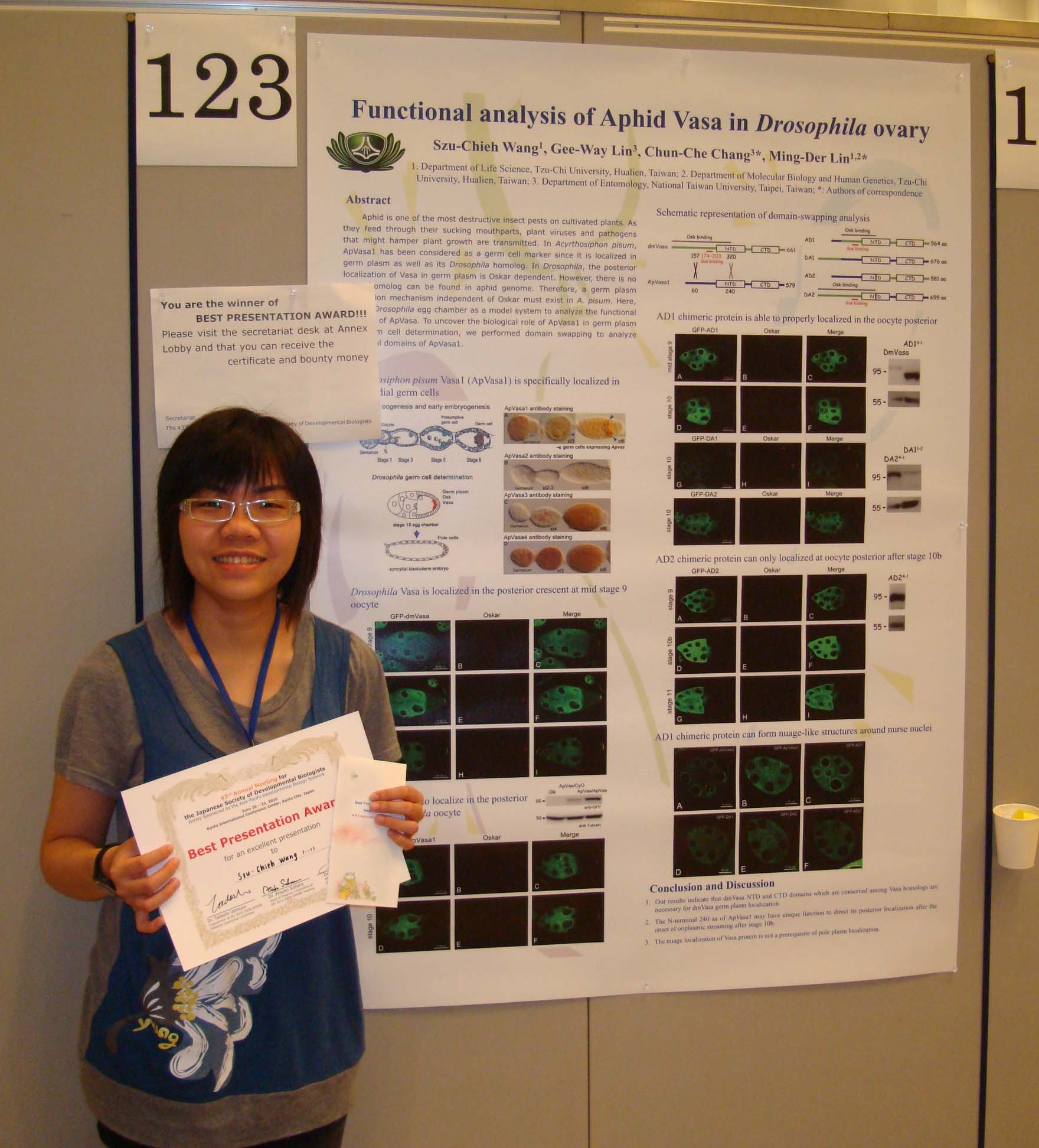林明德老師研究團隊解開Vasa蛋白參與生殖細胞形成的奧秘
生殖細胞的形成的機轉一直以來都是發育生物學重要的課題之一。而在果蠅、線蟲、青蛙與斑馬魚等物種,均透過生殖漿(germ plasm)來決定生殖細胞的形成,而vasa基因就是生殖漿中的主要成分。vasa基因首度在1986年被諾貝爾獎得主Eric Wieschaus的團隊所發現,隨即在1988年同時被Michael Ashburner 與 Yun Nung Jan的研究團隊所解序。雖然vasa基因已經被發現將近30年,並且被認為是後生動物生殖細胞所共有的標記基因,然而對於vasa基因如何參與並決定生殖細胞形成的機制並不明瞭。本校分子生物暨人類遺傳學系林明德老師的研究團隊,解開了 Vasa 蛋白能聚集於果蠅生殖漿 (germ plasm) 和調控生殖細胞特化的關鍵序列,對於昆蟲生殖漿組裝的演化發育意涵,提出突破性的見解。此一研究成果甫刊登於「Scientific Reports」,此期刊為 Nature 出版社近年來發行的跨領域線上科研期刊。
林明德老師表示,這項研究的緣起是在一個偶然的機緣下與國立台灣大學昆蟲學系的張俊哲老師合作,意欲借重果蠅強大的分子遺傳工具來剖析蚜蟲vasa基因的功能,並由當時就讀生命科學系大二的王思捷同學接下這個工作 (王同學隨後加入五年一貫學程)。起初王同學將蚜蟲的Vasa蛋白表現於果蠅的卵巢,發現蚜蟲的Vasa蛋白並不能聚集於果蠅生殖漿也沒有功能。然而,王同學鍥而不捨的將蚜蟲Vasa蛋白與果蠅Vasa蛋白的不同區段嵌合後,竟出現令人驚喜的結果,並發現參與Vasa解旋酶功能的HELICc功能區域,竟然是使果蠅Vasa蛋白能夠聚集於生殖漿的關鍵,並進一步的證實位在第 527 號位置的麩醯氨酸(Glutamine 527, Gln527)為果蠅Vasa蛋白能被招聚於生殖漿的重要分子開關。這項研究並進一步的與生命科學系許豪仁老師合作,以分子模擬的方式來解析位於527號位置的麩醯氨酸對Vasa蛋白結構的可能影響。這項研究的成功,為校內系所間與跨校研究團隊彼此合作幫忙的最佳寫照。王同學並於第43屆日本發育生物學年會上獲得最佳壁報獎並於後續參加的發育生物年會獲得傑出口頭報告獎的殊榮。此項發現使得我們對於昆蟲生殖細胞的發育機轉有更進一步的認識,針對Vasa蛋白的特性所設計的專一性藥物,將可以運用於蟲害管理,例如登革熱與小黑蚊的族群數量控制,並降低對生態環境的衝擊。
In Metazoans, germ cell specification is critical for establishing the germline lineage. For acquiring germline identity, cells can recruit germline determinants from maternal germ plasm, typically preformed in an uncellularised egg chamber, or receive signals from neighbouring cells to induce the expression of germline genes. Since Vasa was first identified as a component of the germ plasm in the fruit fly Drosophila melanogaster about 30 years ago it has been clear that the vasa gene and its products are conserved germline markers across the animal phyla. Nonetheless, how the sequence of vasa relates to the development of germ cells remains largely unknown. This finding unveils a novel role of HELICc in addition to its well-known helicase function to localized Vasa to the germ plasm in Drosophila. By contrast, the divergent N-terminal sequences were not decisive to the germ plasm localization of Vasa though they were involved in the formation of pole cells and abdominal segments. Accordingly, we have greatly advanced the understanding about the connections between sequences and functions of Vasa using evo-devo and genetic approaches. Moreover, our findings shed light on how Vasa can act as a versatile germline marker.

